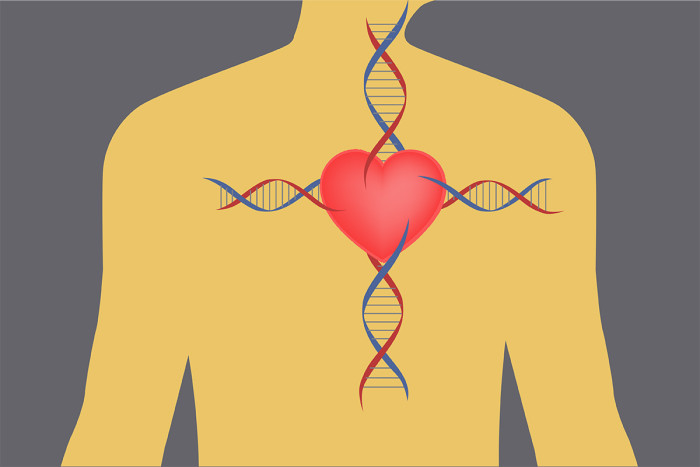Newly identified genetic errors may prevent heart attacks
Findings may guide design of new drugs
 Sara Dickherber
Sara DickherberGenetic errors identified in a new study led by Washington University School of Medicine in St. Louis may reduce risk of heart attacks and serve as a basis for developing new drugs designed to prevent heart disease.
To reduce risk of heart attack, the benefits of a healthy lifestyle are clear. But genetics can still stack the deck. Some people’s genes bestow a natural advantage — or disadvantage — in protecting against heart disease, the leading cause of death worldwide.
Now, a new study that included genetic data from more than 190,000 people has identified two genes that, when altered in specific ways, either promote or undermine cardiovascular health. The findings may help guide efforts to design new preventive drugs, similar to the way statins now are prescribed to lower “bad” cholesterol to reduce the risk of heart disease.
The research, from Washington University School of Medicine in St. Louis, the Broad Institute at Massachusetts Institute of Technology and Harvard, and numerous other institutions, is published online March 2 in The New England Journal of Medicine.
“We identified genetic variation in several genes that associated with protection from coronary heart disease,” said first author Nathan O. Stitziel, MD, PhD, a Washington University cardiologist and assistant professor of medicine and genetics. “Our findings support the idea that therapies focused on a major pathway regulating triglycerides should help prevent the buildup of plaque in the heart’s coronary arteries and protect against heart attacks.”
To identify genes that might be relevant for drug discovery, the investigators plumbed DNA data from patients with coronary disease and from healthy controls. They searched across more than 220,000 genetic variants that altered proteins to identify those that appeared to influence heart disease risk. Errors in proteins can have major physiologic consequences.
As part of the study, the researchers confirmed past work identifying genes already shown to confer an advantage or a vulnerability in protecting against heart disease risk, and they implicated two new ones — ANGPTL4 and SVEP1. Rare errors in ANGPTL4 were associated with reduced risk of coronary artery disease. The reduction varied from 14 percent for a small error in the gene to cutting risk by about 50 percent when an entire copy of the gene was disabled. The other gene, SVEP1, showed the opposite correlation — a rare error increased risk of coronary artery disease by about 14 percent.
While ANGPTL4 has been the subject of much study, the other gene newly implicated in cardiovascular health is a bit of a mystery. In the new study, Stitziel and his colleagues showed that the error in SVEP1 also was linked to higher blood pressure in their study populations, but beyond that there are few clues to what it’s doing.
In contrast, ANGPTL4 has long been known to play a role in processing triglycerides, a type of fat that circulates in the bloodstream. Doctors measure levels of triglycerides as a marker of heart disease risk, though whether these fats play a role in causing plaque to build up in arteries historically has been a matter of debate. ANGPTL4’s role in processing triglycerides is part of a system called the lipoprotein lipase (LPL) pathway. Blocking ANGPTL4 actually opens up this pathway, allowing the body to process triglycerides from the diet and get them out of the bloodstream.
“The gene’s association with lower triglycerides has been known for a while,” said Stitziel, who also sees patients at Barnes-Jewish Hospital. “But for a long time it was not clear that high triglycerides were a cause of coronary disease rather than a marker of it. Now we know that errors in ANGPTL4 associate with both reduced triglycerides and lower risk of coronary disease. This is another piece of the puzzle that points to a causal role for triglycerides in coronary disease.”
“If that’s correct, strategies to lower triglycerides should help,” he added. “Our study indicates that those strategies could include blocking ANGPTL4 or manipulating other elements of the LPL pathway.”
In people with a disabled copy of ANGPTL4, triglyceride levels in the blood are reduced by about 35 percent compared with people who have two working copies of the gene. Stitziel also pointed out that variations in the gene were not associated with changes in levels of “bad” LDL cholesterol. So any drug that impacts this pathway would, in theory, work independently of statins as well as PCSK9 inhibitors, a new and potent cholesterol-lowering therapy that was approved in 2015 by the Food and Drug Administration. Stitziel noted that these recently approved therapeutics that inhibit PCSK9 were developed after similar genetic studies showed an association with LDL cholesterol levels.
“The poster child for human genetic studies leading to new therapies is PCSK9,” Stitziel said. “Rare errors in PCSK9 were first found to cause high LDL cholesterol and different errors were later associated with low LDL cholesterol and protection from coronary disease. And within 12 years of those findings there are now new therapies. The key insight from human genetic studies is the ability to identify biological pathways that are relevant to human disease.”
With future therapeutics in mind, Stitziel pointed out that early versions of inhibitors targeting ANGPTL4 and other members of the LPL pathway are in development. While none of these are clinically approved therapies, the new study linking these genes to reduced coronary disease and lower triglycerides suggests the line of investigation is worth pursuing, he added.
As for the mystery gene implicated in the new study, Stitziel said he and researchers in his lab are now working to unravel the role of SVEP1 in coronary disease risk.






